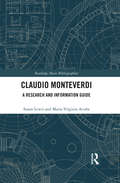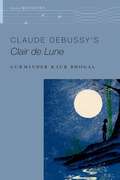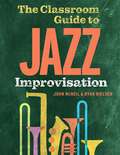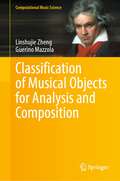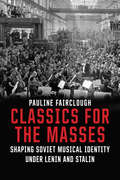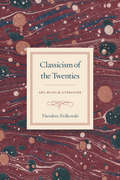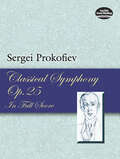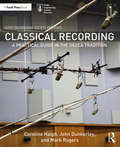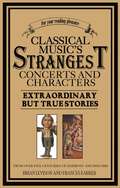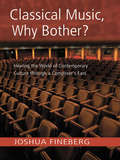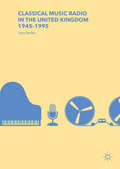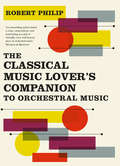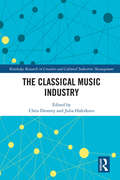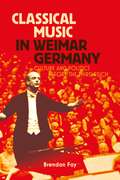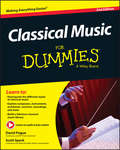- Table View
- List View
Claudio Monteverdi: A Research and Information Guide (Routledge Music Bibliographies)
by Susan Lewis Maria Virginia AcuñaClaudio Monteverdi: A Research and Information Guide is an annotated bibliography that navigates the vast scholarly resources on the composer with the most updated compilation since 1989. Claudio Monteverdi transformed and mastered the principal genres of his day and his works influenced generations of musicians and other artists. He initiated one of the most important aesthetic debates of the era by proposing a new relationship between poetry and harmony. In addition to scholarship by musicologists and music theorists, Monteverdi’s music has attracted attention from literary scholars, cultural historians, and critical theorists. Research into Monteverdi and Renaissance and early baroque studies has expanded greatly, with the field becoming more complex as scholars address such issues as gender theory, feminist criticism, cultural theory, new criticism, new historicism, and artistic and popular cultures. The guide serves both as a foundational starting point and as a gateway for future inquiry in such fields as court culture, opera, patronage, and Italian poetry.
CLAUDE DEBUSSY'S CLAIR DE LUNE OKS C (The Oxford Keynotes Series)
by Gurminder Kaur BhogalDebussy himself had little regard for Clair de Lune, and scholars have thus far followed suit--until now. Claude Debussy's Clair de Lune is the first book wholly dedicated to an historical, cultural, and analytical investigation of the French composer's famous composition for piano. Author Gurminder Kaur Bhogal explores why, over any other piece in Debussy's repertoire for piano, Clair de Lune achieved stardom in the decades following the composer's death, and how, as the third movement of the Suite Bergamasque, it managed to almost fully eclipse the other movements. Drawing on a broad range of excerpts from classical and popular music, commercials, film, and video games, Bhogal examines the various ways in which listeners have engaged with the piece. She also places it in its proper artistic context, through analysis alongside the poetry of Paul Verlaine and the paintings of Jean-Antoine Watteau. A wide range of aural, visual, and video examples energize the narrative, and demonstrate how Clair de Lune has come to achieve an iconic status within and beyond Debussy's oeuvre.
Claude Debussy's Clair de Lune (The Oxford Keynotes Series)
by Gurminder Kaur BhogalDebussy himself had little regard for Clair de Lune, and scholars have thus far followed suit--until now. Claude Debussy's Clair de Lune is the first book wholly dedicated to an historical, cultural, and analytical investigation of the French composer's famous composition for piano. Author Gurminder Kaur Bhogal explores why, over any other piece in Debussy's repertoire for piano, Clair de Lune achieved stardom in the decades following the composer's death, and how, as the third movement of the Suite Bergamasque, it managed to almost fully eclipse the other movements. Drawing on a broad range of excerpts from classical and popular music, commercials, film, and video games, Bhogal examines the various ways in which listeners have engaged with the piece. She also places it in its proper artistic context, through analysis alongside the poetry of Paul Verlaine and the paintings of Jean-Antoine Watteau. A wide range of aural, visual, and video examples energize the narrative, and demonstrate how Clair de Lune has come to achieve an iconic status within and beyond Debussy's oeuvre.
The Classroom Guide to Jazz Improvisation
by John McNeil Ryan NielsenYou don't have to be a jazz expert to give your students a great introduction to improvisation. The Classroom Guide to Jazz Improvisation provides what music educators have sought for decades: an easy, step-by-step guide to teaching jazz improvisation in the music classroom. Offering classroom-tested lesson plans, authors John McNeil and Ryan Nielsen draw on their combined 54 years of teaching experience and extensive work as professional jazz musicians to remove the guesswork and mystique from the teaching process. Each lesson is founded in the authors' realization that the brain responds differently to improvisation than it does rote memory. The resulting lesson plans are flexible, easy to use, and equip students with a quick understanding of the simple choices they can make to create effective jazz lines. Lessons are designed for a range of settings, from ensemble rehearsal to private instruction. Music educators may find relief in the concrete, straightforward materials on rhythm section instruments like bass, drums, piano, and guitar. Beyond the nuts and bolts of improvisation, this book contains carefully curated listening lists, honest discussions about the meaning of the music, and talking points to advocate for jazz programs to administrators and parents. With an inviting and conversational approach, The Classroom Guide to Jazz Improvisation is an essential resource for all music educators, from early career teachers to seasoned instructors.
The Classroom Guide to Jazz Improvisation
by John McNeil Ryan NielsenYou don't have to be a jazz expert to give your students a great introduction to improvisation. The Classroom Guide to Jazz Improvisation provides what music educators have sought for decades: an easy, step-by-step guide to teaching jazz improvisation in the music classroom. Offering classroom-tested lesson plans, authors John McNeil and Ryan Nielsen draw on their combined 54 years of teaching experience and extensive work as professional jazz musicians to remove the guesswork and mystique from the teaching process. Each lesson is founded in the authors' realization that the brain responds differently to improvisation than it does rote memory. The resulting lesson plans are flexible, easy to use, and equip students with a quick understanding of the simple choices they can make to create effective jazz lines. Lessons are designed for a range of settings, from ensemble rehearsal to private instruction. Music educators may find relief in the concrete, straightforward materials on rhythm section instruments like bass, drums, piano, and guitar. Beyond the nuts and bolts of improvisation, this book contains carefully curated listening lists, honest discussions about the meaning of the music, and talking points to advocate for jazz programs to administrators and parents. With an inviting and conversational approach, The Classroom Guide to Jazz Improvisation is an essential resource for all music educators, from early career teachers to seasoned instructors.
Classification of Musical Objects for Analysis and Composition (Computational Music Science)
by Linshujie Zheng Guerino MazzolaThis book presents and discusses the fundamental topic of classification of musical objects, such as chords, motifs, and gestures. Their classification deals with the exhibition of isomorphism classes. Our structure types include local and global constructions, the latter being similar to global structures in geometry, such as differentiable manifolds. The discussion extends to the role, which classification plays for the creative construction of musical compositions. Our examples include references to classical compositions, such as Beethoven’s sonatas, and some of the author’s own compositions of classical and jazz styles. We also discuss software that enables the application of classification to musical creativity. The volume is addressed to an audience that would apply classification to programming and creative musical construction.
Classics for the Masses: Shaping Soviet Musical Identity under Lenin and Stalin
by Pauline FaircloughMusicologist Pauline Fairclough explores the evolving role of music in shaping the cultural identity of the Soviet Union in a revelatory work that counters certain hitherto accepted views of an unbending, unchanging state policy of repression, censorship, and dissonance that existed in all areas of Soviet artistic endeavor. Newly opened archives from the Leninist and Stalinist eras have shed new light on Soviet concert life, demonstrating how the music of the past was used to help mold and deliver cultural policy, how “undesirable” repertoire was weeded out during the 1920s, and how Russian and non-Russian composers such as Mozart, Tchaikovsky, Wagner, Bach, and Rachmaninov were “canonized” during different, distinct periods in Stalinist culture. Fairclough’s fascinating study of the ever-shifting Soviet musical-political landscape identifies 1937 as the start of a cultural Cold War, rather than occurring post-World War Two, as is often maintained, while documenting the efforts of musicians and bureaucrats during this period to keep musical channels open between Russia and the West.
Classicism of the Twenties: Art, Music, and Literature
by Theodore ZiolkowskiThe triumph of avant-gardes in the 1920s tends to dominate our discussions of the music, art, and literature of the period. But the broader current of modernism encompassed many movements, and one of the most distinct and influential was a turn to classicism. In Classicism of the Twenties, Theodore Ziolkowski offers a compelling account of that movement. Giving equal attention to music, art, and literature, and focusing in particular on the works of Stravinsky, Picasso, and T. S. Eliot, he shows how the turn to classicism manifested itself. In reaction both to the excesses of neoromanticism and early modernism and to the horrors of World War I—and with respectful detachment—artists, writers, and composers adapted themes and forms from the past and tried to imbue their own works with the values of simplicity and order that epitomized earlier classicisms. By identifying elements common to all three arts, and carefully situating classicism within the broader sweep of modernist movements, Ziolkowski presents a refreshingly original view of the cultural life of the 1920s.
Classicism of the Twenties: Art, Music, and Literature
by Theodore ZiolkowskiThe triumph of avant-gardes in the 1920s tends to dominate our discussions of the music, art, and literature of the period. But the broader current of modernism encompassed many movements, and one of the most distinct and influential was a turn to classicism. In Classicism of the Twenties, Theodore Ziolkowski offers a compelling account of that movement. Giving equal attention to music, art, and literature, and focusing in particular on the works of Stravinsky, Picasso, and T. S. Eliot, he shows how the turn to classicism manifested itself. In reaction both to the excesses of neoromanticism and early modernism and to the horrors of World War I—and with respectful detachment—artists, writers, and composers adapted themes and forms from the past and tried to imbue their own works with the values of simplicity and order that epitomized earlier classicisms. By identifying elements common to all three arts, and carefully situating classicism within the broader sweep of modernist movements, Ziolkowski presents a refreshingly original view of the cultural life of the 1920s.
Classicism of the Twenties: Art, Music, and Literature
by Theodore ZiolkowskiThe triumph of avant-gardes in the 1920s tends to dominate our discussions of the music, art, and literature of the period. But the broader current of modernism encompassed many movements, and one of the most distinct and influential was a turn to classicism. In Classicism of the Twenties, Theodore Ziolkowski offers a compelling account of that movement. Giving equal attention to music, art, and literature, and focusing in particular on the works of Stravinsky, Picasso, and T. S. Eliot, he shows how the turn to classicism manifested itself. In reaction both to the excesses of neoromanticism and early modernism and to the horrors of World War I—and with respectful detachment—artists, writers, and composers adapted themes and forms from the past and tried to imbue their own works with the values of simplicity and order that epitomized earlier classicisms. By identifying elements common to all three arts, and carefully situating classicism within the broader sweep of modernist movements, Ziolkowski presents a refreshingly original view of the cultural life of the 1920s.
Classicism of the Twenties: Art, Music, and Literature
by Theodore ZiolkowskiThe triumph of avant-gardes in the 1920s tends to dominate our discussions of the music, art, and literature of the period. But the broader current of modernism encompassed many movements, and one of the most distinct and influential was a turn to classicism. In Classicism of the Twenties, Theodore Ziolkowski offers a compelling account of that movement. Giving equal attention to music, art, and literature, and focusing in particular on the works of Stravinsky, Picasso, and T. S. Eliot, he shows how the turn to classicism manifested itself. In reaction both to the excesses of neoromanticism and early modernism and to the horrors of World War I—and with respectful detachment—artists, writers, and composers adapted themes and forms from the past and tried to imbue their own works with the values of simplicity and order that epitomized earlier classicisms. By identifying elements common to all three arts, and carefully situating classicism within the broader sweep of modernist movements, Ziolkowski presents a refreshingly original view of the cultural life of the 1920s.
Classical Symphony, Opus 25: In Full Score
by Sergei ProkofievProkofiev's first symphony, which he mischievously dubbed "Classical," is a sprightly piece based on the symphonic models of Haydn. "I thought that if Haydn were alive today he would compose just as he did before, but at the same time would include something new in his manner of composition," Prokofiev remarked. "I wanted to compose such a symphony: a symphony in the classical style."The composer's synthesis of twentieth harmonies and timbres with eighteenth-century structure and form has captivated audiences since its premiere in 1918. This is Prokofiev's most frequently performed symphonic work, and this edition is meticulously reproduced from an authoritative early source.
Classical Recording: A Practical Guide in the Decca Tradition (Audio Engineering Society Presents)
by Caroline Haigh John Dunkerley Mark RogersClassical Recording: A Practical Guide in the Decca Tradition is the authoritative guide to all aspects of recording acoustic classical music. Offering detailed descriptions, diagrams, and photographs of fundamental recording techniques such as the Decca tree, this book offers a comprehensive overview of the essential skills involved in successfully producing a classical recording. Written by engineers with years of experience working for Decca and Abbey Road Studios and as freelancers, Classical Recording equips the student, the interested amateur, and the practising professional with the required knowledge and confidence to tackle everything from solo piano to opera.
Classical Recording: A Practical Guide in the Decca Tradition (Audio Engineering Society Presents)
by Caroline Haigh John Dunkerley Mark RogersClassical Recording: A Practical Guide in the Decca Tradition is the authoritative guide to all aspects of recording acoustic classical music. Offering detailed descriptions, diagrams, and photographs of fundamental recording techniques such as the Decca tree, this book offers a comprehensive overview of the essential skills involved in successfully producing a classical recording. Written by engineers with years of experience working for Decca and Abbey Road Studios and as freelancers, Classical Recording equips the student, the interested amateur, and the practising professional with the required knowledge and confidence to tackle everything from solo piano to opera.
Classical Music's Strangest Concerts and Characters
by Brian LevisonExtracted from five hundred years of musical history, this is a fascinating collection of stories about classical music's most unusual concerts and characters.
Classical Music, Why Bother?: Hearing the World of Contemporary Culture Through a Composer's Ears
by Joshua FinebergFirst published in 2006. Routledge is an imprint of Taylor & Francis, an informa company.
Classical Music, Why Bother?: Hearing the World of Contemporary Culture Through a Composer's Ears
by Joshua FinebergFirst published in 2006. Routledge is an imprint of Taylor & Francis, an informa company.
Classical Music Radio in the United Kingdom, 1945–1995
by Tony StollerThis book is the first comprehensive account of classical music on all British radio stations, BBC and commercial, between 1945 and 1995. It narrates the shifting development of those services, from before the launch of the Third Programme until after the start of Classic FM, examining the output from both qualitative and quantitative perspectives, as well as recounting some of the stories and anecdotes which enliven the tale. During these fifty years, British classical music radio featured spells of broad, multi-channel classical music radio, with aspirational and mainstream culture enjoying positive interactions, followed by periods of more restricted and exclusive output, in a paradigm of the place of high culture in UK society as a whole. The history was characterised by the recurring tensions between elite and popular provision, and the interplay of demands for highbrow and middlebrow output, and also sheds new light on the continuing relevance of class in Britain. It is an important and unique resource for those studying British history in the second half of the twentieth century, as well as being a compelling and diverting account for enthusiasts for classical music radio.
Classical Music Radio in the United Kingdom, 1945–1995
by Tony StollerThis book is the first comprehensive account of classical music on all British radio stations, BBC and commercial, between 1945 and 1995. It narrates the shifting development of those services, from before the launch of the Third Programme until after the start of Classic FM, examining the output from both qualitative and quantitative perspectives, as well as recounting some of the stories and anecdotes which enliven the tale. During these fifty years, British classical music radio featured spells of broad, multi-channel classical music radio, with aspirational and mainstream culture enjoying positive interactions, followed by periods of more restricted and exclusive output, in a paradigm of the place of high culture in UK society as a whole. The history was characterised by the recurring tensions between elite and popular provision, and the interplay of demands for highbrow and middlebrow output, and also sheds new light on the continuing relevance of class in Britain. It is an important and unique resource for those studying British history in the second half of the twentieth century, as well as being a compelling and diverting account for enthusiasts for classical music radio.
The Classical Music Lover's Companion to Orchestral Music
by Robert PhilipAn invaluable guide for lovers of classical music designed to enhance their enjoyment of the core orchestral repertoire from 1700 to 1950 Robert Philip, scholar, broadcaster, and musician, has compiled an essential handbook for lovers of classical music, designed to enhance their listening experience to the full. Covering four hundred works by sixty-eight composers from Corelli to Shostakovich, this engaging companion explores and unpacks the most frequently performed works, including symphonies, concertos, overtures, suites, and ballet scores. It offers intriguing details about each piece while avoiding technical terminology that might frustrate the non-specialist reader. Philip identifies key features in each work, as well as subtleties and surprises that await the attentive listener, and he includes enough background and biographical information to illuminate the composer’s intentions. Organized alphabetically from Bach to Webern, this compendium will be indispensable for classical music enthusiasts, whether in the concert hall or enjoying recordings at home.
The Classical Music Industry (Routledge Research in the Creative and Cultural Industries)
by Chris Dromey Julia HaferkornThis volume brings together academics, executives and practitioners to provide readers with an extensive and authoritative overview of the classical music industry. The central practices, theories and debates that empower and regulate the industry are explored through the lens of classical music-making, business, and associated spheres such as politics, education, media and copyright. The Classical Music Industry maps the industry’s key networks, principles and practices across such sectors as recording, live, management and marketing: essentially, how the cultural and economic practice of classical music is kept mobile and alive. The book examining pathways to professionalism, traditional and new forms of engagement, and the consequences of related issues—ethics, prestige, gender and class—for anyone aspiring to ‘make it’ in the industry today. This book examines a diverse and fast-changing sector that animates deep feelings. The Classical Music Industry acknowledges debates that have long encircled the sector but today have a fresh face, as the industry adjusts to the new economics of funding, policy-making and retail The first volume of its kind, The Classical Music Industry is a significant point of reference and piece of critical scholarship, written for the benefit of practitioners, music-lovers, students and scholars alike offering a balanced and rigorous account of the manifold ways in which the industry operates.
The Classical Music Industry (Routledge Research in the Creative and Cultural Industries)
by Chris Dromey Julia HaferkornThis volume brings together academics, executives and practitioners to provide readers with an extensive and authoritative overview of the classical music industry. The central practices, theories and debates that empower and regulate the industry are explored through the lens of classical music-making, business, and associated spheres such as politics, education, media and copyright. The Classical Music Industry maps the industry’s key networks, principles and practices across such sectors as recording, live, management and marketing: essentially, how the cultural and economic practice of classical music is kept mobile and alive. The book examining pathways to professionalism, traditional and new forms of engagement, and the consequences of related issues—ethics, prestige, gender and class—for anyone aspiring to ‘make it’ in the industry today. This book examines a diverse and fast-changing sector that animates deep feelings. The Classical Music Industry acknowledges debates that have long encircled the sector but today have a fresh face, as the industry adjusts to the new economics of funding, policy-making and retail The first volume of its kind, The Classical Music Industry is a significant point of reference and piece of critical scholarship, written for the benefit of practitioners, music-lovers, students and scholars alike offering a balanced and rigorous account of the manifold ways in which the industry operates.
Classical Music in Weimar Germany: Culture and Politics before the Third Reich
by Brendan FayFrom Hitler's notorious fondness for Wagner's operas to classical music's role in fuelling German chauvinism in the era of the world wars, many observers have pointed to a distinct relationship between German culture and reactionary politics. In Classical Music in Weimar Germany, Brendan Fay challenges this paradigm by reassessing the relationship between conservative musical culture and German politics. Drawing upon a range of archival sources, concert reviews and satirical cartoons, Fay maps the complex path of classical music culture from Weimar to Nazi Germany-a trajectory that was more crooked, uneven, or broken than straight. Through an examination of topics as varied as radio and race to nationalism, this book demonstrates the diversity of competing aesthetic, philosophical and political ideals held by German music critics that were a hallmark of Weimar Germany. Rather than seeing the cultural conservatism of this period as a natural prelude for the violence and destruction later unleashed by Nazism, this fascinating book sheds new light on traditional culture and its relationship to the rise of Nazism in 20th-century Germany.
Classical Music in Weimar Germany: Culture and Politics before the Third Reich
by Brendan FayFrom Hitler's notorious fondness for Wagner's operas to classical music's role in fuelling German chauvinism in the era of the world wars, many observers have pointed to a distinct relationship between German culture and reactionary politics. In Classical Music in Weimar Germany, Brendan Fay challenges this paradigm by reassessing the relationship between conservative musical culture and German politics. Drawing upon a range of archival sources, concert reviews and satirical cartoons, Fay maps the complex path of classical music culture from Weimar to Nazi Germany-a trajectory that was more crooked, uneven, or broken than straight. Through an examination of topics as varied as radio and race to nationalism, this book demonstrates the diversity of competing aesthetic, philosophical and political ideals held by German music critics that were a hallmark of Weimar Germany. Rather than seeing the cultural conservatism of this period as a natural prelude for the violence and destruction later unleashed by Nazism, this fascinating book sheds new light on traditional culture and its relationship to the rise of Nazism in 20th-century Germany.
Classical Music For Dummies: 2nd Edition (For Dummies)
by David Pogue Scott SpeckHaydn, Tchaikovsky, and Brahms, oh, my! The beginner's guide to classical music Classical Music For Dummies is a friendly, funny, easy-to-understand guide to composers, instruments, orchestras, concerts, recordings, and more. Classical music is widely considered one of the pinnacles of human achievement, and this informative guide will shows you just how beautiful and rewarding it can be. You'll learn how Bach is different from Beethoven, how Mozart is different still, and why not all "classical" music is actually Classical if it's really Baroque or Romantic. You'll be introduced to the composers and their work, and discover the groundbreaking pieces that shake the world every time they're played. Begin building your classical music library with the essential recordings that define orchestral, choral, and operatic beauty as you get acquainted with the orchestras and musicians that bring the composers to life. Whether you want to play classical music or just learn more about it, Classical Music For Dummies will teach you everything you need to know to get the most out of this increasingly popular genre. Distinguish flute from piccolo, violin from viola, and trumpet from trombone Learn the difference between overtures, requiems, arias, and masses Explore the composers that shaped music as we know it Discover the recordings your music library cannot be without Classical music has begun sneaking into the mainstream — if your interest has been piqued, there's never been a better time to develop an appreciation for this incredibly rich, complex, and varied body of work. Classical Music For Dummies lays the groundwork, and demonstrates just how amazing classical music can be.
